9 Traditional Foods for Vietnamese New Year
- Banh Chung / Banh Tet (Vietnamese square sticky rice cake)
- Ga luoc (Boiled chicken)
- Gio lua (Vietnamese sausage)
- Xoi gac (“Gac” sticky rice)
- Nem ran / Cha gio (Deep fried spring rolls)
- Canh bong (Vegetable soup with pig skin)
- Thit kho trung (Braised pork with egg)
- Dua hanh / Cu kieu (Pickled scallion)
- Mut (Candied fruits)
Vietnamese New Year is known as Tet, Tet Nguyen Dan, or Lunar New Year in Vietnam. It is the most important and traditional festival and the longest holiday in the year in Vietnam. Tet is the family reunion occasion for all family members who are studying/ working/ living far from their hometown to come back to visit each other.

The Vietnamese New Year, known as Tết, is a significant event that marks the transition from the old year to the new year, encompassing a range of activities and traditions from the end of the lunar December through the middle of lunar January. A core tradition involves preparing and cooking special foods to present at the ancestor’s altar as a gesture of gratitude, while also enjoying feasts with family, relatives, and guests during the festive period.
Each region in Vietnam showcases distinct traditional dishes with unique flavors. Northern cuisine emphasizes rustic and savory tastes, Central cuisine is known for its spiciness, and Southern cuisine delights with its sweet and diverse profiles. Visiting Vietnam during Tết, regardless of the region, guarantees a memorable culinary journey filled with traditional Vietnamese cuisine.
Here’s a look at 9 Traditional Foods you should consider trying during the Vietnamese New Year celebration in 2025.
Banh Chung / Banh Tet (Vietnamese square sticky rice cake)
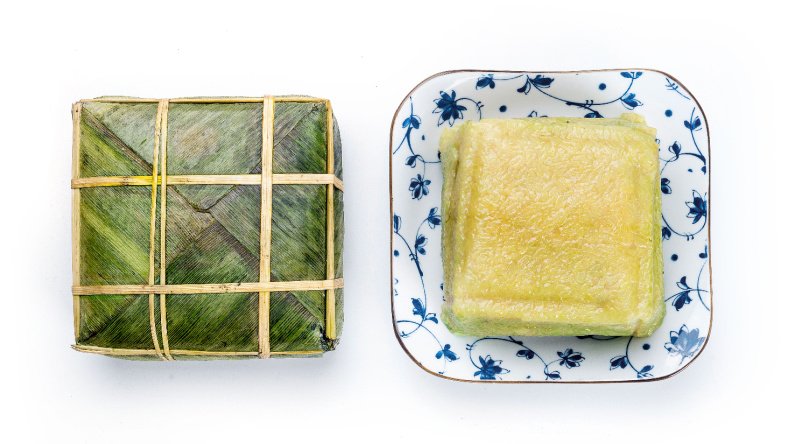
Banh Chung and Banh Tet are traditional rice cakes made from glutinous rice, symbolizing the earth and expressing respect for ancestors. Banh Chung is square and is predominantly made in the North, whereas Banh Tet is cylindrical and popular in Central and Southern regions. Families typically prepare these cakes together, fostering a lively and bonding atmosphere before Tết. These cakes are considered the spirit of the holiday.
Both cakes are crafted from high-quality glutinous rice, cooked mung beans, sliced pork belly, onions, black pepper, and various seasonings. The ingredients are wrapped in “dong” leaves or fresh banana leaves, with rice placed on the outside and filling inside. The cakes are boiled for 12 to 14 hours, with a shelf-life of 7 to 10 days, depending on local conditions. They are a staple during Tết feasts.
Ga luoc (Boiled chicken)
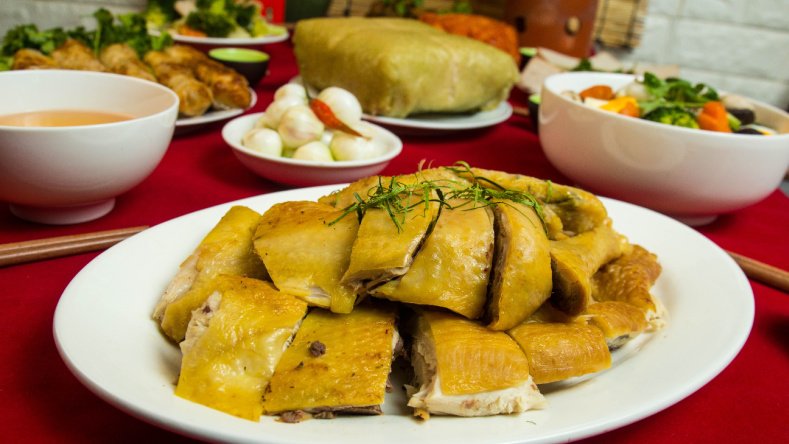
Ga luoc, or boiled chicken, is a simple yet nutritious dish commonly seen in Vietnamese households. While it’s a staple in various meals, it holds special significance during celebrations, including Tết, as it symbolizes abundance and well-being.
The chicken for Tết is typically a healthy rooster, artfully presented after cooking for offerings at the ancestor's altar. When served, it is cut into small, neat pieces and arranged on a plate.
Gio lua (Vietnamese sausage)
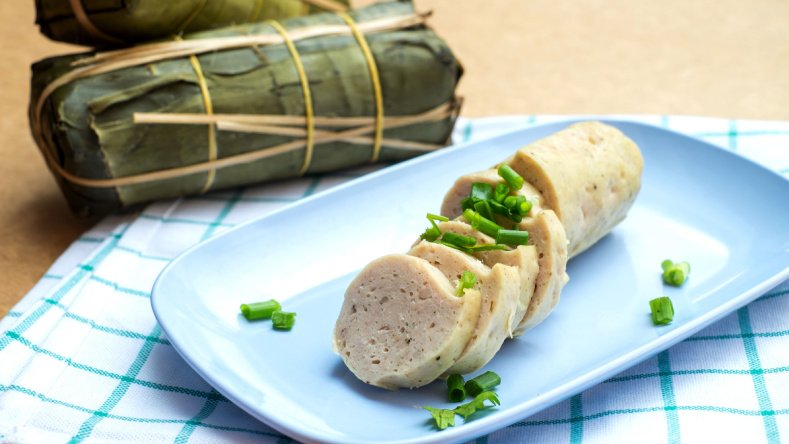
Gio lua, or Vietnamese sausage, is a common feature on Tết tables. Made from finely ground pork or beef, it's wrapped in fresh banana leaves and steamed for around 40 minutes. Best enjoyed alongside sticky rice, Banh Chung, Banh Tet, or steamed rice, it can also be found in a variation called Gio thu, which includes pig's head meat and wood fungus. Gio can be served both hot and cold, while Gio thu is typically served cold for optimal flavor.
Xoi gac (“Gac” sticky rice)

Xoi gac, a unique sticky rice using the gac fruit for a natural red hue, is specially prepared for Tết. In Vietnamese culture, red symbolizes good fortune and happiness. Families often prepare a plate of gac sticky rice on New Year’s Eve or the first day of the lunar new year to usher in luck and prosperity for the year ahead.
Nem ran / Cha gio (Deep fried spring rolls)

Deep-fried spring rolls, known as Nem ran in the North and Cha gio in the South, are a favorite during festive gatherings, particularly at Tết. These rolls are not only straightforward to make but also packed with flavor.
The filling sees a mix of ingredients, including chopped meat (often pork or beef), shrimp, onions, and various mushrooms, seasoned and wrapped in moist rice paper before being deep-fried to a golden crisp. Served best with fresh lettuce and dipping sauce, they are a crowd-pleaser at any Tết celebration.
Canh bong (Vegetable soup with pig skin)
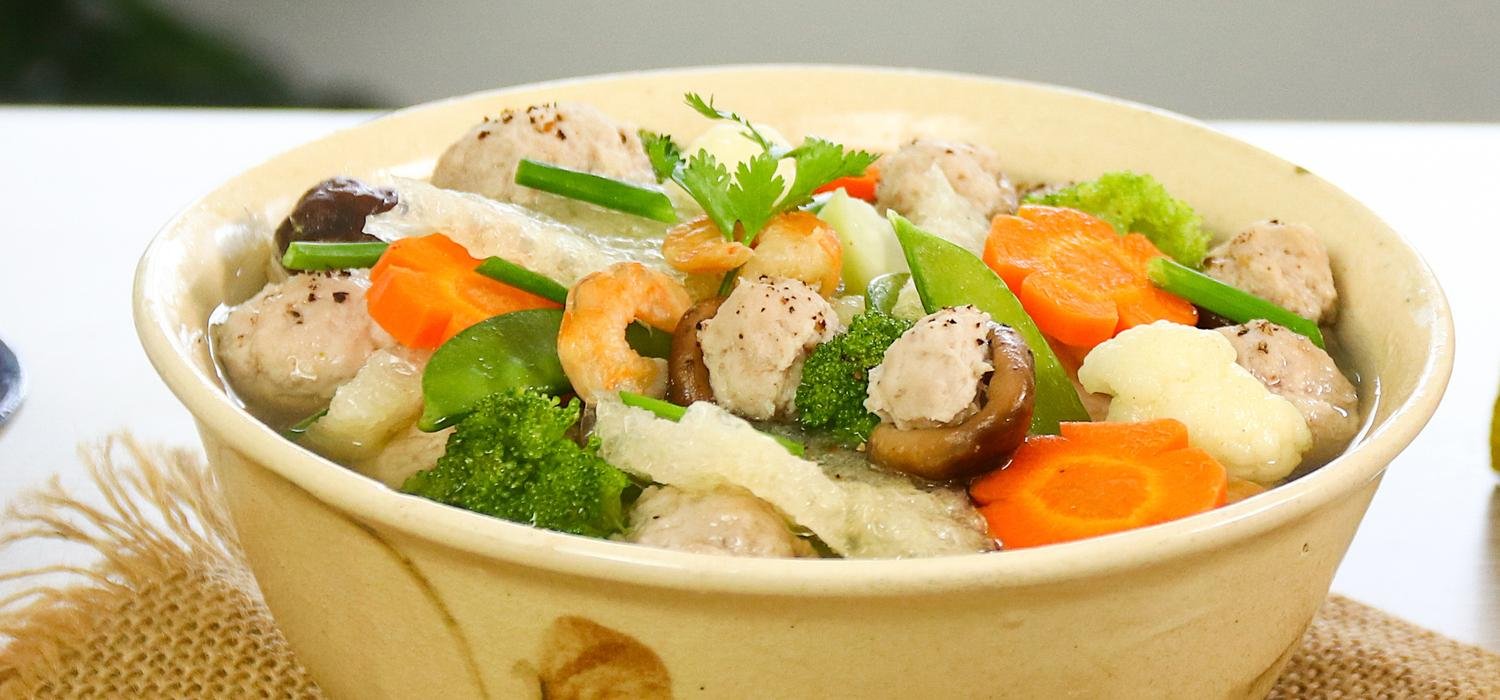
Popular in the North, especially Hanoi, Canh bong features a broth that harmonizes sweetness and richness, accentuated by chewy pig skin, flavorful meatballs, and shrimp. Enhanced with beautifully carved vegetables like carrots, peas, and kohlrabi, this dish makes a visually appealing addition to the Tet meal.
Thit kho trung (Braised pork with egg)
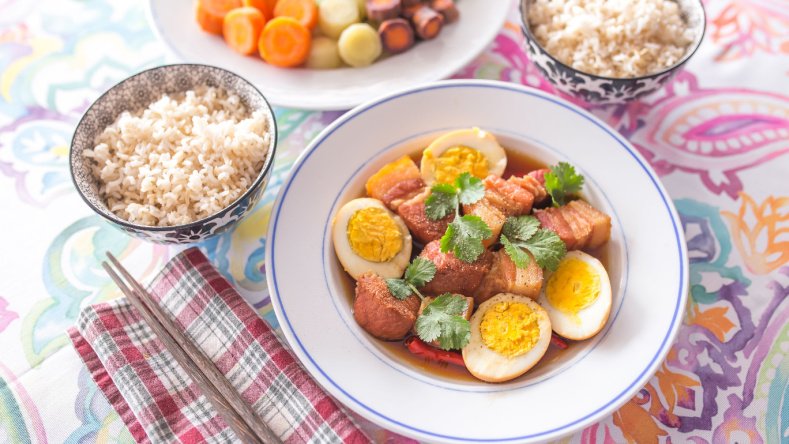
A festive meal would be incomplete without Thit kho trung, a braised pork and egg dish that is particularly beloved in the South but has found its way into Northern households as well. The dish features pork belly marinated with a blend of fish sauce, sugar, garlic, and coconut water, with boiled eggs added to enrich the flavor. After simmering for several hours, this dish is best served over steamed rice, complemented by sweet and sour pickled onions.
Dua hanh / Cu kieu (Pickled scallion)
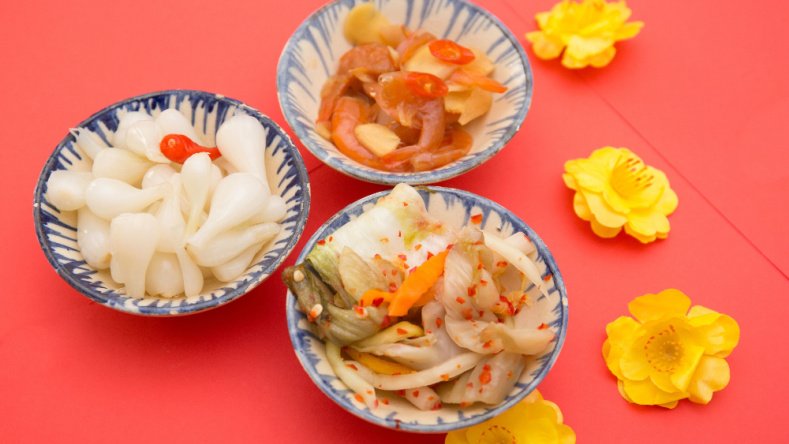
Dua hanh and Cu kieu are simple yet essential pickled scallions that provide a refreshing crunch to the festive meal. Dua hanh are rounder and larger, while Cu kieu are long, slender, and slightly purple. Their tangy and sweet pickled flavor balances the richness of various meat-laden dishes served during Tết festivities. In the South, they may be paired with dried shrimp to enhance flavor profiles.
Mut (Candied fruits)
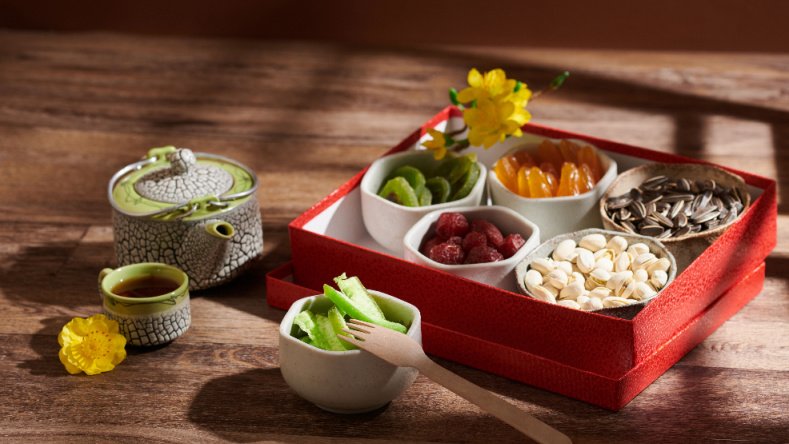
A Tet celebration is incomplete without a tray of “mut” or candied fruits. Unlike traditional jams, Vietnamese mut consists of dried and candied fruits placed on the tea table to welcome guests in the New Year. Items like candied coconut, tamarind, ginger, and various nuts, including pumpkin seeds and cashews, create a cozy and inviting atmosphere, making early-year conversations even more special.













